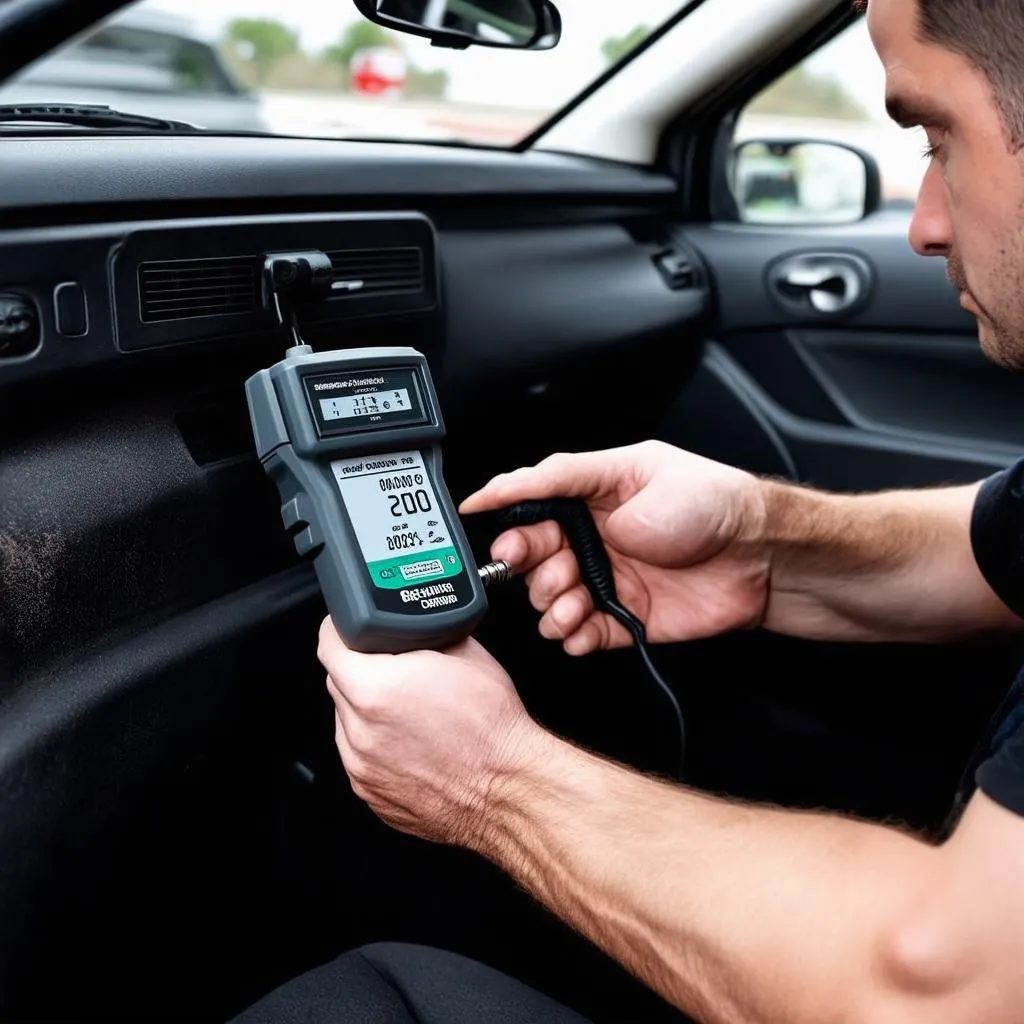“Check Engine” light glaring at you again? Don’t panic, it might just be your car trying to tell you something. Imagine this: you’re cruising down the highway, the engine humming a happy tune, and suddenly, that dreaded yellow light pops up on your dashboard. Frustrating, right? One of the common culprits behind this automotive enigma is the Obd Code P0037.
This code, like a cryptic message from your car’s computer, indicates a potential issue with the oxygen sensor heater control circuit in Bank 1, Sensor 2. Sounds complicated? Fear not, dear reader, for we at techcarusa.com are here to demystify this automotive puzzle. This article will guide you through the ins and outs of the OBD code P0037, explaining what it means, why it occurs, and how to get your car back on track.
What Does Obd Code P0037 Mean?
Let’s break down the jargon. OBD stands for On-Board Diagnostics, which is essentially your car’s internal communication system. This system continuously monitors various components, and when it detects something amiss, it triggers a specific code.
In this case, P0037 refers to the oxygen sensor heater control circuit in Bank 1, Sensor 2. Now, what does that even mean?
- Oxygen Sensor: Think of this as your car’s environmental guardian. It measures the oxygen content in the exhaust gases, ensuring the optimal air-fuel mixture for efficient combustion and reduced emissions.
- Heater Control Circuit: The oxygen sensor needs to be at a certain temperature to function properly. The heater control circuit helps it reach that optimal temperature quickly.
- Bank 1: This refers to the side of the engine where cylinder #1 is located.
- Sensor 2: This indicates the oxygen sensor positioned after the catalytic converter, responsible for monitoring its efficiency.
In essence, the P0037 code signals that the car’s computer has detected a problem with the heater circuit of a specific oxygen sensor. This could be due to a faulty sensor, wiring issues, or a problem with the engine control module (ECM).
Why Should You Care About P0037?
Some might be tempted to ignore this cryptic code, especially if the car seems to be running fine. However, neglecting it could lead to more significant problems down the road.
For one, a malfunctioning oxygen sensor can disrupt the air-fuel mixture, causing:
- Decreased fuel economy: Imagine pouring money down the drain every time you fill up your tank – that’s precisely what happens with poor fuel economy.
- Increased emissions: A misfiring engine releases more harmful pollutants into the environment.
- Poor engine performance: Your car might experience rough idling, hesitation, or even stalling.
- Damage to the catalytic converter: The catalytic converter is a costly component, and a faulty oxygen sensor can shorten its lifespan.
Besides the practical implications, some believe that car troubles, particularly those related to the engine, can disrupt the car’s energy flow. In certain spiritual practices, a smoothly running engine symbolizes balance and harmony, while a troubled one might indicate underlying blockages or negativity.
Unraveling the Causes of Obd Code P0037
Several culprits can trigger the P0037 code, some more common than others. Here’s a breakdown of the usual suspects:
- Faulty Oxygen Sensor: This is often the primary culprit. Like any other car component, oxygen sensors have a lifespan and can wear out over time.
- Damaged Wiring Harness: The wiring connecting the oxygen sensor to the ECM can become frayed, corroded, or disconnected, disrupting the signal flow.
- Blown Fuse: A blown fuse in the oxygen sensor heater circuit can interrupt the power supply.
- Faulty ECM: While less common, a malfunctioning ECM can misinterpret signals or fail to provide the necessary voltage to the heater circuit.
Diagnosing and Fixing the P0037 Code
Now that we’ve identified the potential culprits, let’s explore how to pinpoint the exact cause and get your car back in tip-top shape.
DIY Diagnosis
While consulting a trusted mechanic is always recommended, some preliminary checks can be done at home:
- Visually inspect the oxygen sensor and wiring harness for any visible damage.
- Check the fuse related to the oxygen sensor heater circuit.
- Use an OBD-II scanner to read the code and clear it.
Important: If the code reappears after clearing it, further diagnosis is necessary.
Professional Diagnosis and Repair
A qualified mechanic will have the tools and expertise to perform a comprehensive diagnosis, including:
- Verifying the code with an advanced scan tool.
- Testing the oxygen sensor heater circuit for proper voltage and resistance.
- Inspecting the wiring harness for continuity and shorts.
- Testing the ECM for functionality.
Based on the diagnosis, the mechanic will recommend the necessary repairs, which may include replacing the oxygen sensor, repairing the wiring harness, or addressing any issues with the ECM.
 oxygen sensor replacement
oxygen sensor replacement
Frequently Asked Questions
How much does it cost to fix Obd Code P0037?
The cost of repair can vary depending on the underlying cause and labor rates. Replacing a faulty oxygen sensor typically costs between $200 and $400, while repairing a wiring harness might range from $100 to $300. ECM issues can be more expensive, potentially exceeding $1000 in some cases.
Can I drive my car with code P0037?
While you might be able to drive for a short distance, it’s not advisable to ignore the code. Driving with a faulty oxygen sensor can lead to further damage and increased repair costs.
How often should I replace my oxygen sensors?
Oxygen sensors typically last between 60,000 and 90,000 miles. However, it’s best to consult your car’s owner’s manual for specific recommendations.
Related OBD Codes and Car Models
Several other OBD codes are related to the oxygen sensor system, including:
- P0030: HO2S Heater Control Circuit (Bank 1, Sensor 1)
- P0031: HO2S Heater Control Circuit Low (Bank 1, Sensor 1)
- P0032: HO2S Heater Control Circuit High (Bank 1, Sensor 1)
- P0038: HO2S Heater Control Circuit High (Bank 1, Sensor 2)
The P0037 code can occur in various car makes and models, including but not limited to:
- Volvo (especially V70 models)
- Audi
- Volkswagen
- BMW
- Mercedes-Benz
For specific information related to Volvo V70 OBD code P0037, you can refer to our dedicated articles:
 obd scanner diagnostics
obd scanner diagnostics
Need Expert Help?
Dealing with car troubles can be stressful. If you’re experiencing the OBD code P0037 or any other automotive issue, our team of experts at techcarusa.com is here to help. We specialize in providing top-notch diagnostic tools and software solutions, including Dealer Scanner For European Cars, to assist you in identifying and resolving car problems effectively.
Don’t hesitate to reach out to us via WhatsApp at +84767531508 for expert guidance and support. Our dedicated team is available 24/7 to answer your questions and provide personalized solutions for all your automotive needs.
Keep Your Car Running Smoothly
Understanding your car’s warning signs is crucial for its longevity and your peace of mind. Addressing the OBD code P0037 promptly can save you from costly repairs and ensure a smooth and efficient driving experience. Remember, regular maintenance, timely diagnosis, and expert assistance are key to keeping your car happy and you stress-free.
Did you find this article helpful? Share your thoughts and experiences in the comments below! For more insightful articles on car maintenance and repair, explore our website techcarusa.com.